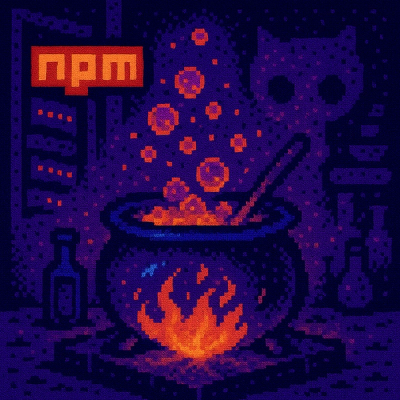
Security News
The Changelog Podcast: Practical Steps to Stay Safe on npm
Learn the essential steps every developer should take to stay secure on npm and reduce exposure to supply chain attacks.
@epmkit/epm-extend-core
Advanced tools
该项目为 EPM 扩展机制核心库
执行 npm install @epmkit/epm-extend-core 来引入该库。
执行 npm start 进行开发
public 目录下的文件并不是用来发布的,而是调试用的例子插件。
执行 npm run build 进行编译
在宿主环境中执行 npm install @epmkit/epm-extend-core 来引入该库。
与该库配套使用的 @epmkit/cra-template-epm-plugin 用来创建插件仓库。
引入方法如下所示:
import React, { useEffect, useState } from 'react';
import Extend from '@epmkit/epm-extend-core';
const ExtendContext = React.createContext('Extend');
// 在节点中
function App() {
const [ExtendInstance, setExtendInstance] = useState(new Extend());
useEffect(() => {
async function initExtend() {
cosnt config = await fetchPluginList(nodeCode); // 获取当前节点的插件插槽配置
ExtendInstance.init(config);
setExtendInstance(ExtendInstance);
}
initExtend();
return () => {
ExtendInstance.dispose();
};
}, []);
return (
<ExtendContext.Provider value={ExtendInstance.Slot}>
<ChildElement />
</ExtendContext.Provider>
);
}
// 在组件中
function ChildElement() {
const Slot = React.useContext(ExtendContext);
// 可针对单个插槽关闭 js 沙箱
return <Slot name='slot-name' sandbox={false} fn={{
fnAAA: () => {/* 事件回调 */},
fnBBB: () => {/* 事件回调 */}
}} data={{
dataAAA: '', // 传递数据
dataBBB: {}
}} />;
}
在节点的最外层执行 React.createContext('Extend') 创建扩展机制执行上下文
在节点中执行 new Extend(options) 创建 扩展机制实例 ExtendInstance
扩展机制支持对一些配置进行自定义设置,具体可设置属性如下:
| 字段 | 含义 | 类型 | 默认值 |
|---|---|---|---|
| defaultStyleUrl | 默认样式CSS地址 | string | //design.yonyoucloud.com/static/tinper-next/release/tinper-next.css |
| windowScope | 插件绑定到window对象上的属性 | string | epmPlugin |
| sandbox | 是否开启js沙箱 | boolean | true |
在适当的时机执行实例的 init 方法,并传入插件插槽配置。init 时传入的 config 变量为当前节点的插件插槽配置项,需要符合特定的数据结构,以下为例子:
config = {
pluginList: [
{
name: 'aSmallBtn',
scriptEntry: 'http://localhost:3030/plugin-aSmallBtn.e76d9341.js',
styleEntry: 'http://localhost:3030/plugin-aSmallBtn.ababa1e9.css',
version: '1.3.0',
sandbox: false,
},
{
name: 'aSelectExample',
scriptEntry: 'http://localhost:3030/plugin-aSelectExample.e86c0e5e.js',
styleEntry: 'http://localhost:3030/plugin-aSelectExample.5df6a4d9.css',
chunks: ['http://localhost:3030/js/plugin-chunk.155.cb4c80ac.js'],
version: '1.4.1',
},
],
slotList: [
{
name: 'slot-a',
plugins: ['aSelectExample', 'aSmallBtn'],
},
{
name: 'slot-b',
plugins: ['aSelectExample'],
},
{
name: 'slot-c',
plugins: [{ name: 'aSelectExample', version: '1.4.1' }],
},
],
};
各字段含义如下
| 字段 | 含义 | 类型 | 例子 | 是否必需 |
|---|---|---|---|---|
| pluginList | 当前节点的插件列表 | Array<Plugin> | - | √ |
| Plugin.name | 插件名 | string | aSmallBtn | √ |
| Plugin.scriptEntry | 插件脚本文件入口地址 | string | http://localhost:3030/plugin-aSmallBtn.e76d9341.js | √ |
| Plugin.styleEntry | 插件样式文件入口地址 | string | http://localhost:3030/plugin-aSmallBtn.ababa1e9.css | - |
| Plugin.chunks | 插件的分包 | Array<URL> | ['http://localhost:3030/js/plugin-chunk.155.cb4c80ac.js'] | - |
| Plugin.version | 插件的版本 | string | 1.3.0 | - |
| Plugin.sandbox | 是否开启沙箱,默认开启,可设置为 false 对单个插件关闭 | boolean | false | - |
| slotList | 当前节点的插槽配置 | Array<Slot> | - | √ |
| Slot.name | 插槽名 | string | slot-a | √ |
| Slot.plugins | 当前插槽的插件列表 | Array<string|Plugin> | - | √ |
将扩展机制实例的插槽 ExtendInstance.Slot 作为上下文的值传递给子组件
在子组件适当的位置使用 <Slot name='slot-name' /> 注入插槽
EPM 扩展机制核心库是和插件配置来使用的,插槽的开发者使用核心库来配置插槽和传递的数据方法,插件开发者需要开发插件来注入应用。
插件开发者执行 npx create-react-app ${plugin-repo-name} --template @epmkit/cra-template-epm-plugin 来创建插件仓库,其中 ${plugin-repo-name} 为插件仓库的名称。
插件的开发同普通 React 组件开发方式相同,只不过组件的 props 是通过插槽传递过来的数据。
一个插件例子如下:
export default function SamllBtn({ fn, data, emit, on }) {
const { btnName, isBtnShow } = data;
const { hideBtn, showBtn } = fn;
useEffect(() => {
on('anotherPlugin:message', payload => {
console.log('receiveMessage', payload);
});
}, []);
const handleClick = useCallback(() => {
if (isBtnShow) {
hideBtn();
return;
}
showBtn();
emit('smallBtnClick', !isBtnShow);
}, [hideBtn, isBtnShow, showBtn]);
return (
<Button
className='plugin-btn'
style={{ width: 400 }}
onClick={handleClick}
type='primary'>{`${btnName}按钮`}</Button>
);
}
插件的 props 含义如下:
| 字段名 | 含义 | 例子 |
|---|---|---|
| fn | 由插槽定义的方法,通过执行方法改变页面状态 | - |
| data | 由插槽传递的数据,获取当前插槽传递的实时数据 | - |
| emit | 插件间通信方法,发送事件与数据 | emit('event', data) |
| on | 插件间通信方法,监听其他插件发送的事件并对载荷做出处理 需要注意的是,监听时需要带上监听的插件名,插件名和事件之间以冒号 : 连接 | on('pluginName:event', (payload) =>{}) |
FAQs
Core library of EPM extension plugin mechanism.
We found that @epmkit/epm-extend-core demonstrated a not healthy version release cadence and project activity because the last version was released a year ago. It has 2 open source maintainers collaborating on the project.
Did you know?

Socket for GitHub automatically highlights issues in each pull request and monitors the health of all your open source dependencies. Discover the contents of your packages and block harmful activity before you install or update your dependencies.

Security News
Learn the essential steps every developer should take to stay secure on npm and reduce exposure to supply chain attacks.

Security News
Experts push back on new claims about AI-driven ransomware, warning that hype and sponsored research are distorting how the threat is understood.

Security News
Ruby's creator Matz assumes control of RubyGems and Bundler repositories while former maintainers agree to step back and transfer all rights to end the dispute.